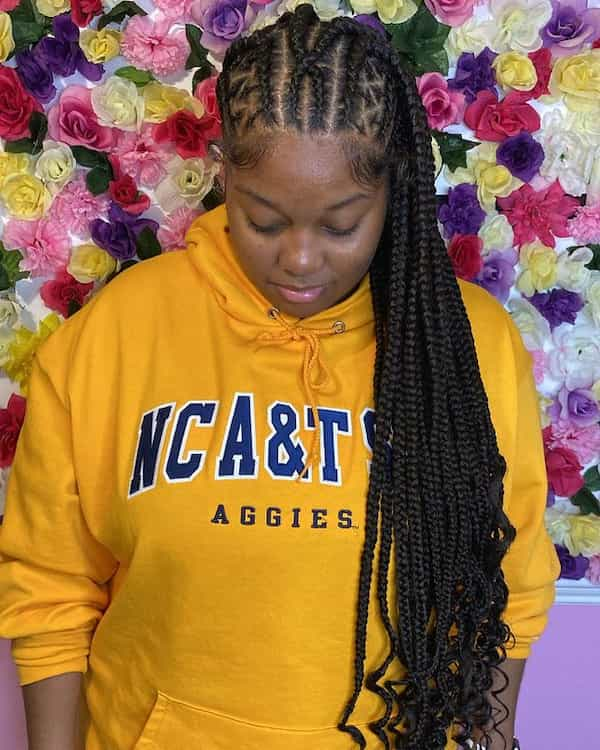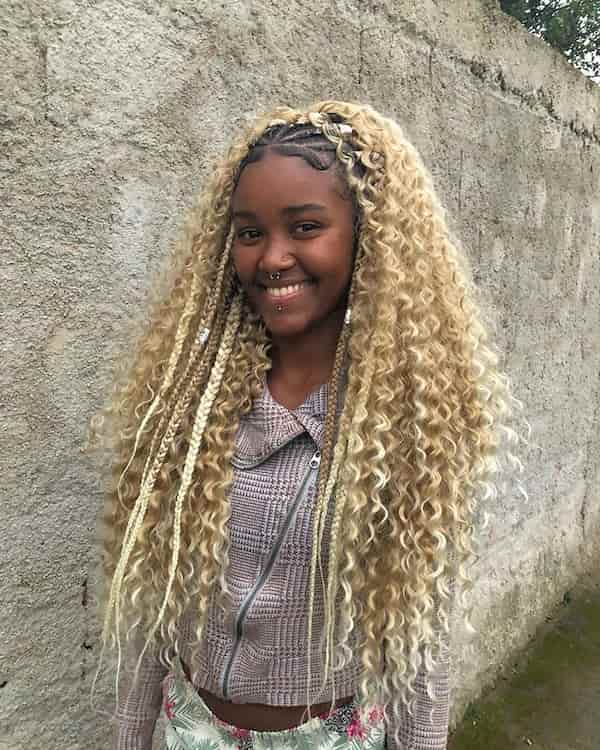Are you ready to transform your look and embrace a hairstyle steeped in history and brimming with style? Fulani braids offer a captivating blend of cultural heritage and modern flair, making them a standout choice for anyone seeking a protective and visually stunning hairstyle.
Originating from the Fulani people of West Africa, these braids are more than just a trend; they are a symbol of identity and cultural pride. Characterized by their intricate cornrow patterns, flowing individual braids, and often adorned with beads and cowrie shells, Fulani braids provide a unique canvas for self-expression. This hairstyle's roots lie deep within the Fulani culture, where it was traditionally a way to express status, age, and marital status. The meticulous braiding techniques passed down through generations are a testament to the artistry and skill of the Fulani people. Today, Fulani braids have transcended their cultural origins and become a global phenomenon, beloved for their versatility, protective qualities, and undeniable beauty. They represent a fusion of tradition and contemporary style, allowing individuals to connect with a rich heritage while embracing modern aesthetics.
| Feature | Details |
|---|---|
| Origin | West Africa, specifically the Fulani people |
| Characteristics | Cornrow patterns, individual braids, often adorned with beads and cowrie shells |
| Cultural Significance | Symbol of identity, expression of status, age, and marital status |
| Versatility | Adaptable to various hair textures, lengths, and styles |
| Protective Qualities | Helps protect natural hair from breakage and environmental damage |
| Popular Variations | Goddess braids, high ponytails, space buns, braids with curls |
| Materials Needed | Hair extensions (kanekalon), styling products, beads, cowrie shells |
| Maintenance | Regular moisturizing of the scalp and hair, avoiding excessive tension, protecting braids at night |
| Lifespan | Typically 4-8 weeks, depending on care and hair growth |
| Inspiration | Celebrities, influencers, and traditional Fulani hairstyles |
The beauty of Fulani braids lies in their adaptability. They can be customized to suit any individual's preferences, hair type, and personal style. Whether you desire a classic, elegant look or something more daring and contemporary, Fulani braids provide a versatile foundation. Consider the various styles available: goddess braids, characterized by their thicker, more voluminous braids; high ponytails, which offer a sleek and sophisticated appearance; space buns, a playful and youthful option; and braids with curls, which introduce a touch of softness and romance. Each variation provides a unique way to showcase your personality and creativity.
One of the most appealing aspects of Fulani braids is their protective nature. Braiding your hair in this style can safeguard your natural hair from environmental damage, reduce breakage, and promote hair growth. By keeping your hair tucked away, you minimize the impact of harsh weather conditions, such as wind and sun exposure. This is particularly beneficial for those with delicate or easily damaged hair. The protective benefits of Fulani braids extend beyond environmental protection; they also allow your natural hair to retain moisture, reducing dryness and preventing split ends. Additionally, the reduced manipulation of your hair while it is braided minimizes breakage, enabling your hair to grow longer and healthier.
If you're considering getting Fulani braids, here are some tips to prepare: first, consult with a professional braider experienced in Fulani styles to ensure the best results. They can assess your hair type and recommend the most suitable braid size, length, and style. Before your appointment, wash and condition your hair thoroughly. This will provide a clean and healthy base for the braids, helping them last longer. Also, consider the materials needed. You'll likely need hair extensions (often Kanekalon braiding hair), styling products (such as edge control and hair mousse), and any accessories like beads or cowrie shells. Communicate your desired style clearly with your braider, bringing photos or examples for reference. This ensures that you're both on the same page and that you'll love the final result. Be prepared for the installation process, which can take several hours, depending on the complexity of the style. Lastly, remember to moisturize your scalp regularly while your braids are in, to keep both your hair and scalp healthy.
Caring for Fulani braids is essential to maintain their beauty and longevity. Regular maintenance includes moisturizing your scalp and braids. Use a light oil or hair serum to prevent dryness. Avoid pulling or tugging on the braids, as this can cause breakage and discomfort. Protect your braids while sleeping by wrapping them in a silk scarf or using a satin pillowcase. This helps to reduce friction and prevent frizzing. It's also important to keep your braids clean. Gently wash your braids every 2-3 weeks, using a mild shampoo and warm water. Avoid harsh chemicals and excessive scrubbing. The lifespan of Fulani braids typically ranges from four to eight weeks, depending on how well they are cared for and how quickly your hair grows. When it's time to remove your braids, be patient and careful. Use a professional or follow a tutorial to ensure you don't damage your natural hair during the removal process.
Fulani braids are more than just a hairstyle; they are a statement. They embody a fusion of tradition, creativity, and self-expression. Whether you're drawn to the classic elegance, the protective benefits, or the ability to customize your look, Fulani braids offer an exciting and transformative experience. With a rich cultural heritage and diverse styling options, these braids continue to captivate individuals around the world. Embrace the beauty and versatility of Fulani braids and explore how they can elevate your style and connect you to a rich cultural legacy. As you experiment with variations, accessories, and maintenance techniques, remember that Fulani braids represent not only a fashion choice but also a celebration of culture and individuality.
From the intricate cornrow patterns to the individual braids adorned with beads and cowrie shells, Fulani braids provide a canvas for self-expression that's both stylish and protective. The numerous variations, including goddess braids, high ponytails, space buns, and braids with curls, ensure there's a Fulani braid style to suit every individual's taste and hair type. The beauty lies in the versatility of these braids; they can be adapted to suit any occasion, from everyday wear to special events. Whether you are looking for a classic, elegant look or something more daring, Fulani braids offer an exciting and transformative journey.
The art of creating Fulani braids is deeply rooted in West African traditions, particularly among the Fulani people. Historically, these braids served as a symbol of identity, reflecting status, age, and marital status within the community. The intricate patterns and embellishments were often passed down through generations, representing both artistry and cultural pride. Today, Fulani braids have become a global trend, embraced by people from all backgrounds who appreciate the beauty, versatility, and protective qualities of this hairstyle. Celebrities and influencers alike have helped popularize these braids, showcasing a wide range of styles and inspiring new interpretations of this age-old art form.
One of the most compelling reasons to choose Fulani braids is their ability to protect your natural hair. By keeping your hair neatly tucked away, these braids shield your strands from harsh environmental factors like sun, wind, and pollution. This is especially beneficial for those with fragile or easily damaged hair. Moreover, Fulani braids help retain moisture, reducing dryness and preventing split ends. With less manipulation and exposure to damaging elements, your natural hair can grow longer and healthier over time. This protective quality makes Fulani braids a smart choice for maintaining and enhancing your natural hair’s vitality.
Before you get Fulani braids, thorough preparation is key. Finding an experienced stylist familiar with this intricate style is essential. Communicate your desired style clearly, perhaps by providing pictures of the look you want. Before your appointment, wash and condition your hair thoroughly to ensure a clean and healthy base for the braids. Consider the materials needed, which typically include hair extensions (often Kanekalon braiding hair), styling products (like edge control), and any accessories such as beads. Remember that the braiding process can take several hours, so be prepared to dedicate enough time to the appointment. This detailed preparation ensures the best possible result and keeps your hair healthy.
Once your Fulani braids are in place, proper maintenance is vital to prolonging their beauty and lifespan. Moisturizing your scalp and braids regularly with a light oil or serum prevents dryness and maintains the health of your hair and scalp. Avoid pulling or tugging on the braids, as this can cause discomfort and potentially damage your natural hair. Protecting your braids while you sleep by wrapping them in a silk scarf or using a satin pillowcase reduces friction and prevents frizzing. Gently wash your braids every two to three weeks, using a mild shampoo and warm water, while avoiding harsh chemicals and excessive scrubbing. Fulani braids typically last between four to eight weeks, depending on the care and the rate of your hair growth. When the time comes to remove your braids, approach the process with patience and care, or consult a professional to ensure your natural hair remains undamaged.
Fulani braids are a testament to the beauty of cultural fusion and the power of self-expression. From their West African roots to their global appeal, these braids offer a unique blend of tradition and modern style. Whether you're looking for a protective hairstyle, a versatile look, or a way to connect with a rich cultural heritage, Fulani braids are an excellent choice. Embrace the creativity, explore the different styles, and experience the transformative power of this iconic hairstyle.



